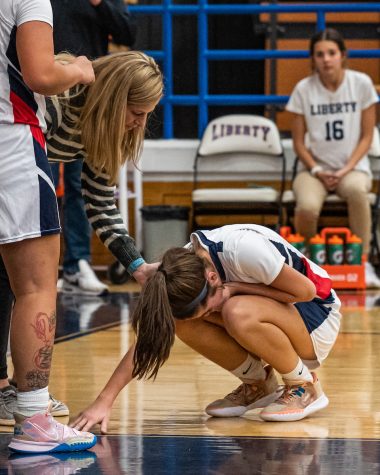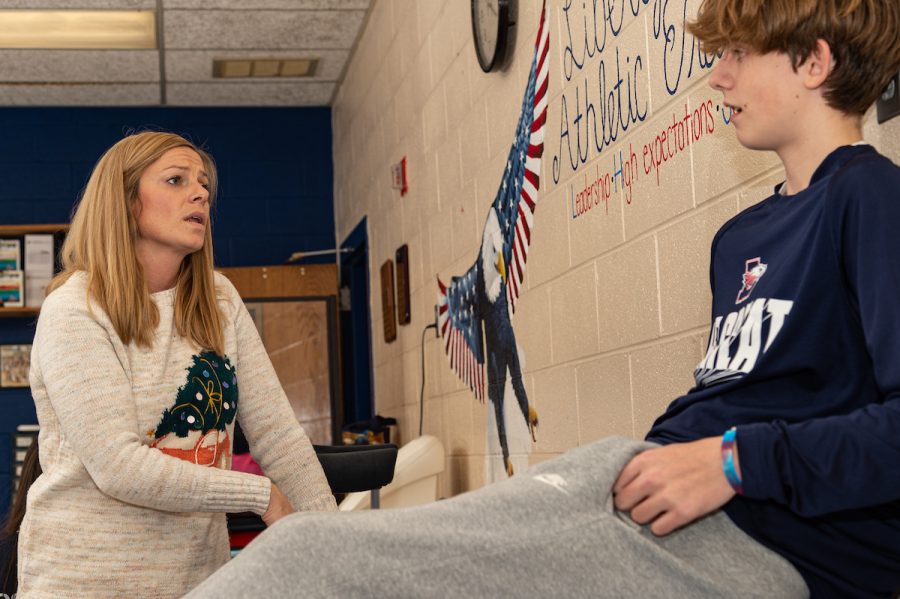Pain Game
Athletic trainers keep Eagle athletes on field and in class.
Coach Mandy Carter converses with sophomore Luke Wilson in the training room. Photo courtesy of the yearbook staff.
March 1, 2023
Athletic trainers provide a variety of services to scholastic athletes including prevention, assessment, evaluation, immediate care and treatment of injuries, rehabilitation, counseling, and education.
They are often the first line of defense in preventing and treating sports-related injuries by providing prompt recognition, management, and referral of injury or illness. Athletic trainers collaborate with physicians to develop an appropriate plan of action for each athlete they treat.
Trainers also help athletes return to play safely following an injury or illness by developing athletic training programs that involve stretching and strengthening exercises designed to facilitate healing while minimizing further injury risk.
The duties of athletic trainers can vary significantly depending on their place of employment. In general, though, they must be able to assess injuries and illnesses promptly and accurately, administer emergency care when necessary, develop rehabilitation programs and treatment plans, instruct athletes in preventative measures to reduce their risk of injury or illness, and provide education on nutrition, lifestyle choices, and overall health.
At Liberty High School this team consists of Mrs. Mandy Carter and her students. Carter provides the expertise and instructs students how to execute training tasks to assist in real time situations.
She and her students provide these services to LHS athletic teams and their players. While they may focus on helping students prepare to avoid injuries before games or help rehab between them, a large part of their job is to help athletes mid-game when serious to mild injuries happen.
“When I was playing football I hurt my elbow. The athletic trainer gave me a hot compress and gave me a compressive sleeve. I was out for a week till she gave me the clear,” said Jacob Whitt.
Athletic trainers must be certified by the state in which they work. They are certified after they successfully pass the Board of Certification Exam. They must also keep current with research and advances in sports medicine to ensure that the athletes under their care receive the best possible care. Athletic trainers are an essential part of any athletic team’s healthcare program. Their expertise is invaluable for keeping athletes healthy and performing at the highest level possible.
“I attended Shenandoah University where they offer a five-year Master’s program. This program prepares you for different clinical rotations and sitting for your BOC medical test. Once I passed this board of medicine test, I applied to the state and the NATA (National Athletic Trainer’s Association) for my licensure,” said Carter.
This intense certification process helps them make important on-the-spot decisions.
“Athletic trainers have to evaluate non-life-threatening injuries, while remaining calm, cool, and collected,” said Carter.
A comprehensive evaluation can reveal the problem that is plaguing an athlete before it becomes a bigger problem. This can eliminate unnecessary pain and discomfort and diminish the amount of time spent away from their sport.
“I always call it a win when an athlete, who returns to full play from a time loss injury, completes a game,” said Carter. “Also when athletes can perform at their highest level and remain injured free that’s a bigger win.”
An athletic trainer is always happy when nothing happens, but when it does a fast recovery is even better.




Logan Pribble • Sep 5, 2023 at 1:15 pm
It’s always good to know there is always acknowledgment for the people behind the scenes of sports even though they’re the ones that make it all happen.